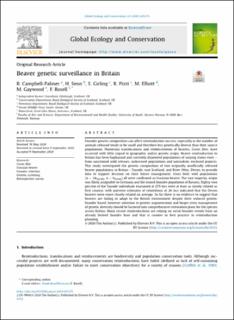| dc.contributor.author | Campbell-Palmer, Róisín | |
| dc.contributor.author | Senn, Helen V. | |
| dc.contributor.author | Girling, Simon Justin | |
| dc.contributor.author | Pizzi, Romain | |
| dc.contributor.author | Elliott, Mark | |
| dc.contributor.author | Gaywood, Martin J. | |
| dc.contributor.author | Rosell, Frank | |
| dc.date.accessioned | 2021-03-25T10:49:52Z | |
| dc.date.available | 2021-03-25T10:49:52Z | |
| dc.date.created | 2021-02-24T13:15:14Z | |
| dc.date.issued | 2020 | |
| dc.identifier.citation | Campbell-Palmer, R., Senn, H., Girling, S., Pizzi, R., Elliott, M., Gaywood, M. & Rosell, F. (2020). Beaver genetic surveillance in Britain. Global Ecology and Conservation, 24, e01275. | en_US |
| dc.identifier.issn | 2351-9894 | |
| dc.identifier.uri | https://hdl.handle.net/11250/2735493 | |
| dc.description.abstract | Founder genetic composition can affect reintroduction success, especially as the number of animals released tends to be small and therefore less genetically diverse than their source populations. Numerous translocations and reinforcements of beavers, Castor fiber, have occurred with little regard to geographic and/or genetic origin. Beaver reintroduction to Britain has been haphazard and currently disjointed populations of varying status exist – from sanctioned wild releases, unlicensed populations and naturalistic enclosed projects. This study investigated the genetic composition of two originally unofficially released beaver populations in Britain - Tayside, east Scotland, and River Otter, Devon, to provide data to support decision on their future management. From both wild populations (n = 34Tayside, n = 9Devon) all were confirmed as Eurasian beaver. The vast majority, origin was likely assignable to Germany and the mixed founder population of Bavaria. Eighty-two percent of the Tayside individuals examined at 275 loci were at least as closely related as first cousins, with pairwise estimates of relatedness at 26 loci indicated that the Devon beavers were more closely related on average. So far there is no evidence to suggest that beavers are failing to adapt to the British environment despite their reduced genetic founder based, however attention to genetic augmentation and longer-term management of genetic diversity should be factored into comprehensive restoration plans for the species across Britain. Many recent reintroductions are relying on serial founder events from an already limited founder base and that is counter to best practice in reintroduction planning. | en_US |
| dc.language.iso | eng | en_US |
| dc.rights | Navngivelse 4.0 Internasjonal | * |
| dc.rights.uri | http://creativecommons.org/licenses/by/4.0/deed.no | * |
| dc.title | Beaver genetic surveillance in Britain | en_US |
| dc.type | Peer reviewed | en_US |
| dc.type | Journal article | en_US |
| dc.description.version | publishedVersion | en_US |
| dc.rights.holder | © 2020 The Author(s). | en_US |
| dc.source.volume | 24 | en_US |
| dc.source.journal | Global Ecology and Conservation | en_US |
| dc.identifier.doi | https://doi.org/10.1016/j.gecco.2020.e01275 | |
| dc.identifier.cristin | 1893202 | |
| dc.source.articlenumber | e01275 | en_US |
| cristin.ispublished | true | |
| cristin.fulltext | original | |
| cristin.qualitycode | 1 | |

